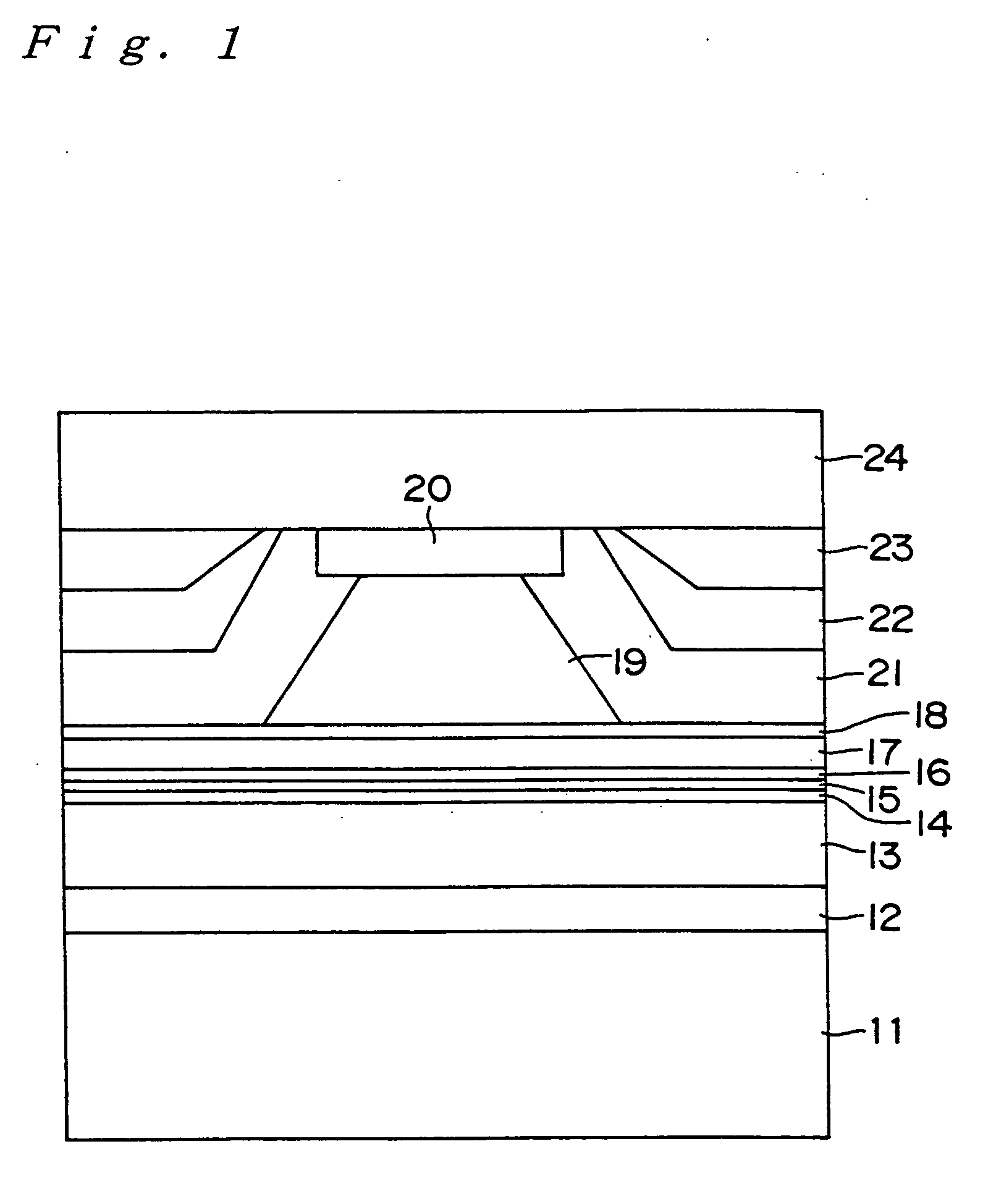Semiconductor laser device and optical disc drive
a semiconductor laser and optical disc technology, applied in semiconductor lasers, laser details, electrical devices, etc., can solve the problems of short device life, difficult to surely obtain good ingaasp crystals under this condition, and affecting reliability, so as to achieve high-reliability semiconductor laser devices, the effect of preventing degradation of the strained quantum well active region and sufficiently reducing the temperature of spinodal decomposition
- Summary
- Abstract
- Description
- Claims
- Application Information
AI Technical Summary
Benefits of technology
Problems solved by technology
Method used
Image
Examples
first embodiment
FIG. 1 is a cross sectional view showing a constitution in a semiconductor laser device of the present embodiment. FIG. 2 is a schematic cross sectional view showing a process for producing the semiconductor laser device shown in FIG. 1. The present embodiment relates to a semiconductor laser device whose oscillation wavelength belongs to a 0.78-μm band, the semiconductor laser device having a quantum well active region made of InGaAsP well layers and having a compressive strain of larger than 0.25 and smaller than 1.0%.
As shown in FIG. 1, in the semiconductor laser device of the present embodiment, the following layers are sequentially formed on an n-type GaAs substrate 11: an n-type GaAs buffer layer (layer thickness of 0.5 μm) 12, an n-type Al0.5Ga0.5As lower cladding layer (layer thickness of 1.7 μm) 13, a lower light-guiding layer 14 consisting of two layers of an i-type Al0.3Ga0.7As (layer thickness of 40 nm) and an i-type Al0.2Ga0.8As (layer thickness of 5 nm) sequentially ...
second embodiment
FIG. 5 is a cross sectional view showing a constitution of a semiconductor laser device of the second embodiment. In the semiconductor laser device of the present embodiment, as shown in FIG. 5, on an n-type GaAs substrate 31, there are sequentially stacked an n-type GaAs buffer layer (layer thickness of 0.5 μm) 32, an n-type Al0.4Ga0.6As lower first cladding layer (layer thickness of 1.5 μm) 33a, an n-type Al0.5Ga0.5As lower second cladding layer (layer thickness of 1.5 μm) 33b, an i-type Al0.35Ga0.65As lower light-guiding layer (layer thickness of 30 nm) 34, a multiquantum well active region (oscillation wavelength of 0.78 μm) 35, an i-type Al0.35Ga0.65As upper light-guiding layer (layer thickness of 30 nm) 36, a p-type Al0.5Ga0.5As upper first cladding layer (layer thickness of 0.2 μm) 37, a p-type GaAs etching stopper layer (layer thickness of 3 nm) 38, a p-type Al0.5Ga0.5As upper second cladding layer (layer thickness of 1.2 μm) 39 and a p-type GaAs contact layer (layer thickne...
third embodiment
FIG. 6 is a cross sectional view showing a constitution in a semiconductor laser device of the third embodiment. As shown in FIG. 6, in the semiconductor laser device of the present embodiment, on an n-type GaAs substrate 51, there are sequentially stacked an n-type GaAs buffer layer (layer thickness of 0.5 μm) 52, an n-type Al0.4Ga0.6As lower first cladding layer (layer thickness of 1.3 μm) 53a, an n-type Al0.5Ga0.5As lower second cladding layer (layer thickness of 1.0 μm) 53b, a lower light-guiding layer 54 consisting of two layers of an i-type Al0.35Ga0.65As (layer thickness of 30 nm) and an i-type Al0.25Ga0.75As (layer thickness of 3 nm) in this order, a multiquantum well active region (oscillation wavelength of 0.78 μm) 55, an upper light-guiding layer 56 consisting of two layers of an i-type Al0.25Ga0.75As (layer thickness of 3 nm) and an i-type Al0.35Ga0.65As (layer thickness of 30 nm) in this order, a p-type Al0.5Ga0.5As upper first cladding layer (layer thickness of 0.2 μm)...
PUM
 Login to View More
Login to View More Abstract
Description
Claims
Application Information
 Login to View More
Login to View More - R&D
- Intellectual Property
- Life Sciences
- Materials
- Tech Scout
- Unparalleled Data Quality
- Higher Quality Content
- 60% Fewer Hallucinations
Browse by: Latest US Patents, China's latest patents, Technical Efficacy Thesaurus, Application Domain, Technology Topic, Popular Technical Reports.
© 2025 PatSnap. All rights reserved.Legal|Privacy policy|Modern Slavery Act Transparency Statement|Sitemap|About US| Contact US: help@patsnap.com



